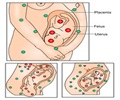A new study has found that tobacco use and exposure to second-hand smoke during pregnancy are major health threats in several low and middle-income countries, like India and Pakistan.
A new study has found that tobacco use and exposure to second-hand smoke during pregnancy are major health threats in several low and middle-income countries, like India and Pakistan.
Experiments conducted by a National Institute of Health (NIH) study indicated that in few of the countries sampled, including some in Latin America, rates of tobacco-related exposures might already be high enough to warrant substantial concern.“This study indicates that public health officials in developing nations should take immediate steps to prevent and reduce tobacco use and secondhand smoke exposure among pregnant women,” said Duane Alexander, M.D., Director of the National Institute of Child Health and Human Development (NICHD).
“This should include efforts to better understand the scope of the problem, so as to best direct public health interventions,” he added.
The study was conducted by an international team of investigators, including researchers from the National Cancer Institute (NCI) and NICHD, two NIH institutes.
The researchers conducted the study at ten sites in the NICHD Global Network for Women’s and Children’s Health Research, which focuses on improving maternal and child health in the developing world. Approximately 8,000 pregnant women were surveyed at five sites in Latin America (Argentina, Uruguay, Ecuador, Brazil and Guatemala), two sites in Africa (Zambia and the Democratic Republic of the Congo) and three sites in Asia (two in India and one in Pakistan).
The survey looked at pregnant women’s use of tobacco products (cigarettes and smokeless tobacco), their perceptions of the social acceptability of tobacco use for women, and exposure to second-hand smoke experienced by them and their young children.
“Preventing an increase in tobacco use by women in the developing world is widely recognized as a significant public health opportunity. Our results demonstrate that pregnant women’s tobacco use and exposure to secondhand smoke threaten to impede or reverse ongoing efforts to improve maternal and child health in the developing world,” said lead author Michele Bloch, M.D., Ph.D., of NCI’s Tobacco Control Research Branch.
The researchers found as many as 18 percent of pregnant women currently smoked cigarettes, up to one-third used smokeless tobacco, and as many of half were regularly exposed to second-hand smoke in the nations studied. The researchers also found evidence that in some countries where pregnant women’s tobacco use is currently low, rates of smoking during pregnancy could increase dramatically if barriers to women’s tobacco use were removed.
Uruguay and Argentina had the highest levels of smoking during pregnancy across all ten-study sites (18 percent and 10 percent respectively). While the three other Latin American sites reported fewer women smoking during pregnancy, all had large numbers of respondents who had tried cigarettes at least once.
In the Indian sites, one-third of all pregnant women used smokeless tobacco in Orissa and about twenty percent of pregnant women in Karnataka were often exposed to second-hand smoke.
The highest levels of second-hand smoke exposure were found in Pakistan, where about half of all pregnant women and their young children were frequently or always exposed to second-hand smoke. About one in ten pregnant women at the site in Pakistan reported that they had tried cigarette smoking.
Advertisement
Smoking during pregnancy causes a number of problems, including preterm delivery, low birth weight and sudden infant death syndrome. For the mother, cigarette use can lead to lung and other cancers, coronary heart disease, stroke, and chronic obstructive pulmonary diseases. Smokeless tobacco use can lead to oral and pancreatic cancers. Secondhand smoke causes lung cancer and heart disease in adults, and can lead to serious illnesses, such as bronchitis and pneumonia in infants and children.
Advertisement
“These data highlight the urgent need to adopt proven measures to prevent and control tobacco use -- both cigarettes and smokeless tobacco -- and secondhand smoke exposure of women and girls worldwide,” she added.
The study will appear in the April 2008, issue of the American Journal of Public Health, with advance online publication on February 28, 2008.
Source-ANI
SRM/L











